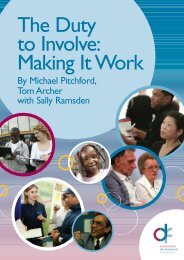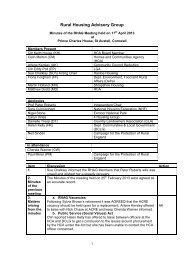Rapid Evidence Assessment of the Research ... - Rural Housing
Rapid Evidence Assessment of the Research ... - Rural Housing
Rapid Evidence Assessment of the Research ... - Rural Housing
You also want an ePaper? Increase the reach of your titles
YUMPU automatically turns print PDFs into web optimized ePapers that Google loves.
<strong>Rapid</strong> <strong>Evidence</strong> <strong>Assessment</strong> <strong>of</strong> <strong>the</strong> <strong>Research</strong> Literature on <strong>the</strong> Purchase and Use <strong>of</strong> Second Homes<br />
8. Has <strong>the</strong>re been any improvement<br />
in <strong>the</strong> supply and quality <strong>of</strong> <strong>the</strong><br />
housing stock as a result <strong>of</strong><br />
second home purchases?<br />
Introduction<br />
156. This chapter reviews evidence on both <strong>the</strong> direct and indirect effects <strong>of</strong> second home purchase on<br />
improvements in housing supply <strong>the</strong>n on improvements in housing quality.<br />
The direct effects <strong>of</strong> second home purchase on improving housing supply<br />
157. It might be anticipated that second home purchase in particular locations would stimulate <strong>the</strong> supply <strong>of</strong><br />
housing, but virtually all discussion concerning <strong>the</strong> direct relationship between second homes and supply<br />
assumes that <strong>the</strong>y reduce availability, typified by this comment from <strong>the</strong> 2004 Suffolk County Council study <strong>of</strong><br />
‘Possible Impacts’ that:<br />
44<br />
“Increasing numbers <strong>of</strong> second homes contribute to a decreasing supply <strong>of</strong> available housing” (p9).<br />
158. However, <strong>the</strong> evidence for this trend is very limited, and <strong>the</strong> general problem in <strong>the</strong> locations affected, for<br />
example, in high demand locations in Devon, Cornwall, Norfolk and Suffolk, in national parks and AONBs,<br />
appears to be that <strong>the</strong>re is an overall lack <strong>of</strong> housing supply as tight controls on new residential development<br />
result in high land and property values.<br />
159. One potential effect <strong>of</strong> <strong>the</strong> demand for second homes in rural areas might be that some ‘problematic<br />
vacants’ (Fielder & Smith, 1996) which are:<br />
“unoccupied for substantial periods <strong>of</strong> time and are <strong>of</strong>ten in poor condition” (Wallace et al,<br />
2005, p2).<br />
are brought back into use. The consultation paper on empty homes issued by <strong>the</strong> ODPM (2003b) identified<br />
that investment properties and those held by two co-habiting owners might be viewed as second homes, and<br />
o<strong>the</strong>r relevant properties might include vacant properties formerly housing agricultural workers. However, no<br />
evidence <strong>of</strong> this trend is available.<br />
The indirect effects <strong>of</strong> second home purchase on improving housing supply<br />
160. The main evidence that second home purchase has had an indirect effect on improving housing supply<br />
has been provided by research examining <strong>the</strong> impact <strong>of</strong> local authorities having <strong>the</strong> discretion to reduce <strong>the</strong><br />
discount on Council Tax for owners <strong>of</strong> second homes; a policy change introduced in April 2004. <strong>Research</strong><br />
undertaken by De Montfort University (Oxley & Brown, 2006) on behalf <strong>of</strong> <strong>the</strong> Commission for <strong>Rural</strong><br />
Communities sought to evaluate <strong>the</strong> early impacts <strong>of</strong> this policy, mainly in relation to <strong>the</strong> financial year 2004/5.<br />
In particular, it considered <strong>the</strong> extent to which <strong>the</strong> new power was used by local authorities to provide new<br />
resources to increase <strong>the</strong> supply <strong>of</strong> affordable housing and related services.<br />
161. Structured telephone interviews were undertaken with a sample <strong>of</strong> rural authorities in England, with a bias<br />
in favour <strong>of</strong> those with a large proportion <strong>of</strong> second homes. The local authorities contacted comprised <strong>of</strong> 18<br />
counties, 42 districts and 4 unitary authorities, and a response rate <strong>of</strong> 93 per cent was achieved.






